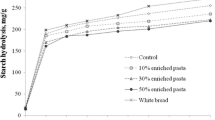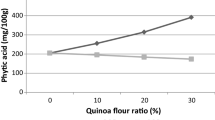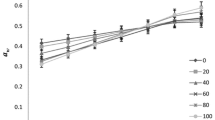Abstract
Yam flour (Dioscorea schimperiana) prepared by traditional (TPYF) and modified (MPYF) processes has been used as an ingredient, to develop bio-functionally enriched pasta. The yam flours have been blended with Durum semolina flour at different levels (10, 20, 30 & 60%) to produce pasta. The cooking quality, antioxidant potential, digestibility profile and sensory profile of the blended pasta have been evaluated. Above all the substituted yam based pasta, the cooking loss was within the permissible level (8%). The β-carotene content of MPYF substituted pasta was significantly higher compared to TPYF samples. The incorporation of yam flour substantially improved total phenolic content (2.9 and 1.7 fold for 60% substituted MPYF and TPYF respectively as compared to control). The same trend was observed with the antioxidant capacity (ABTS - 3.80 and 1.41 fold; RSA - 2.21 and 1.72 fold; FRAP - 14.48 and 11.22 fold respectively for 60% MPYF and TPYF sample as compared to control). The in vitro starch digestibility was reduced significantly among the samples (62.35% in control pasta to 46.41% in 60%MPYF and 50.01% in 60%TPYF samples). The starch profile indicated a significant decrease of rapidly digestible starch (62.63% in control to 43.55% in 60%MPYF and 43.04% in 60%TPYF samples). Sensory evaluation revealed that pasta with up to 30% yam flour was acceptable. Dioscorea schimperiana can be used to improve pasta nutritional quality. For better functional potential, modified process yam flour is suitable.

Similar content being viewed by others
References
FAO, FAO corporate document repository produced by: economic and social development department. World Agric. (2015)
W.C. Hou, M.H. Lee, H.J. Chen, W.L. Liang, C.H. Han, Y.W. Liu, Y.H. Lin, Antioxdant activities of dioscorin, the storage protein of yam (Dioscorea batatas Decne) tuber. J. Agric. Food Chem. 49, 4956–4960 (2001)
H.K. Go, M.M. Rahman, G.B. Kim, C.S. Na, C.H. Song, J.S. Kim, S.H. Kang, Antidiabetic effects of Yam (Dioscorea batatas) and its active constituent, allantoin, in a rat model of streptozotocin-induced diabetes. Nutrients 7, 8532–8544 (2015)
C.K. Riley, P.S. Bahado-Singh, A.O.B. Wheatley, H.N. Asemota, Physicochemical properties of low-amylose yam (Dioscorea spp.) starches and its impact on α-amylase degradation in vitro. Intern. J. Nut. Food Sci. 3, 448–454 (2014)
J. Singh, A. Dartois, L. Kaur, Starch digestibility in food matrix: a review. Trends Food Sci. Technol. 21, 168–180 (2010)
S. Birger, K.H. Astrid. Digestion and metabolic fates of starch, and its relation to major nutrition-related health problems: a review. Starch/Stärke 68, 302–313 (2016)
FAO, FAOSTAT database collections. Food and agriculture organization of the United Nations (FAO, FAOSTAT database collections, Rome, 2013). http://faostat.fao.org. Accessed 22 April 2013
M.S. Leng, I. Gouado, R. Ndjouenkeu, Blanching and drying behaviour of Dioscorea schimperiana and impact on cellular exchanges and on calcium, ascorbic acid and β-carotene contents. Am. J. Food Technol. 6, 362–373 (2011)
C. Tchiegang, N. Ngueto, Données sur les valeurs culturelles, ethno nutritionnelles et physico-chimiques de Dioscorea schimperiana (Hoscht) de l’Ouest Cameroun. Tropicultura 27, 35–39 (2009)
M.S. Leng, Optimisation des conditions du procédé de séchage de l’igname (Dioscorea schimperiana Hoscht) pour la réduction des pertes en β-carotène et en vitamine C. Thèse de Doctorat/PhD, Université de Ngaoundéré, Cameroun. (2012), p 217
A. Bell, Influence des transformations technologiques sur la valeur nutritionnelle des ignames au Cameroun (Thèse de Doctorat de 3e cycle, Université de Paris 6e, France, 1981), p 89
A. Bell, J. Favier, Influence des transformations technologiques traditionnelles sur la valeur nutritive des ignames (Dioscorea spp.) du Cameroun. Rev. Sci. Technol. 1–2, 135–150 (1982)
N. Akissoé, J. Hounhouigan, C. Mestres, M. Nago, How blanching and drying affect the colour and functional characteristics of yam (Dioscorea cayenensis-rotundata) flour. Food. Chem. 82, 257–264 (2003)
I. Khan, A. Yousif, S.K. Johnson, S. Gamlath, Effect of sorghum flour addition on resistant starch content, phenolic profile and antioxidant capacity of durum wheat pasta. Food Res. Intern. 54, 578–586 (2013)
B. Dhiraj, P. Prabhasankar, Influence of wheat-milled products and their additive blends on pasta dough rheological, microstructure and product quality characteristics. Intern. J. Food Sci. (2013). doi:10.1155/2013/538070
American Association of Cereal Chemists, AACC Method 44-15A, one Stage Moisture Air Oven Method; AACC Method 08–01, Ash-Basic Method; AACC Method 46–13, Micro-Kjeldahl Method; AACC Method 22-10A; AACC Method 16–50 (10th ed.). Approved Methods of the AACC. Instrumental Texture analysis and colour measurement; AACC Method 66-50.01; Pasta cooking time 66–50, AACC, AACC 2, method 54–21 (American Association of Cereal Chemists, St. Paul, 2000)
P.C. Cardoso, A.P.B. Tomazini, P.C. Stringheta, S.M. Ribeiro, H.M. Pinheiro-Sant’Ana, Vitamin C and carotenoids in organic and conventional fruits grown in Brazil. Food chem. 126, 411–416 (2011)
H. Azevedo-Meleiro, D.B. Rodriguez-Amaya, Confirmation of the identity of the carotenoids of tropical fruits by HPLC-DAD and HPLC-MS. J. Food Compo. Anal. 17, 385–396 (2004)
M. Vijaykrishnaraj, K.S. Bharath, P. Prabhasankar, Green mussel (Perna canaliculus) as a marine ingredient to enrich gluten free pasta: product quality, microstructure and biofunctional evaluation. J. Food Meas. Charac. 9, 76–85 (2015)
S.B. Kumar, P. Prabhasankar, A study on noodle dough rheology and product quality characteristics of fresh and dried noodles as influenced by low glycaemic index ingredient. J. Food Sci. Technol. 52, 1404–1413 (2015)
S. Susanna, P. Prabhasankar, A comparative study of different bio-processing methods for reduction in wheat flour allergens. Eur. J. Food Res. Technol. 233, 999–1006 (2011)
I. Goñi, A. Garcia-Alonso, F. Saura-Calixto, A starch hydrolysis procedure to estimate glycemic index. Nutr. Res. 17, 427–437 (1997)
R.M. Nguimbou, Potentiel nutritionnel et propriétés physico-chimiques des poudres de tubercules de Cyrtosperma merkusii (H. Schott). Thèse de Doctorat. Spécialité : Sciences Alimentaire Nutrition. Ecole Nationale Supérieure des Sciences Agro-Industrielles (ENSAI), (Université de Ngaoundéré-Cameroun/Ecole Doctorale Ressources, Procédés, produits, environnement laboratoire d’ingénierie des biomolécules, France, 2012)
G.J. McDougall, F. Shpiro, P. Dobson, P. Smith, A. Blake, D. Stewart, Different polyphenolic components of soft fruits inhibit α-amylase and α-glucosidase. J. Agric. Food chem. 53, 2760–2766 (2005)
V.L. Singleton, J.A. Rossi, Colorimetry of total phenolic with phosphomolybdic-phosphotungstic acid reagents. Am. J. Enol. Vitic. 16, 144–158 (1965)
S.K. Chandini, P. Ganesan, N. Bhaskar, In vitro antioxidant activities of three selected brown seaweeds of India. Food chem. 107, 707–713 (2008)
R. Re, N. Pellegrini, A. Proteggente, A. Pannala, M. Yang, C. Rice-Evans, Antioxidant activity applying an improved ABTS radical cation decolorization assay. Free Rad. Bio. Med. 26, 1231–1237 (1999)
F. Benzie, J.J. Strain, The ferric reducing ability of plasma (FRAP) as a measure of “antioxidant power”: the FRAP assay. Anal. Biochem. 239, 70–76 (1996)
S. Trèche, T. Agbor Egbe, Composition chimique des ignames cultivées au Cameroun II. Composition glucidique. Rev. Sci. Technol. 4, 23–44 (1987)
S. Chillo, J. Laverse, P.M. Falcone, M.A. Del Nobile, Quality of spaghetti in base amaranthus wholemeal flour added with quinoa, broad bean and chick pea. J. Food Eng. 84, 101–107 (2008)
C.S. Brennan, C.M. Tudorica, Evaluation of potential mechanisms by which dietary fibre additions reduce the predicted glycaemic index of fresh pastas. Intern. J. Food Sci. Techol. 43, 2151–2162 (2008)
M.A. Gimenez, R.J. Gonzalez, J. Wagner, R. Torres, M.O. Lobo, N.C. Samman, Effect of extrusion conditions on physicochemical and sensorial properties of corn-broad beans (Vicia faba) spaghetti type pasta. Food. Chem. 136, 538–545 (2013)
C.L. Hsu, S.L. Hurang, W. Chen, Y.M. Weng, C.Y. Tseng, Qualities and antioxidant properties of bread as affected by the incorporation of yam flour in the formulation. Intern. J. Food Sci. Techol. 39, 231–238 (2004)
M. Boroski, A.C. de Aguiar, J.S. Boeing, E.M. Rotta, C.L. Wibby, E.G. Bonafé, J.V. Visentainer, Enhancement of pasta antioxidant activity with oregano and carrot leaf. Food chem. 125, 696–700 (2011)
A. Bhatt, V. Patel, Antioxidant activity of garlic using conventional extraction and in vitro gastrointestinal digestion. Free Rad. Antioxid. 3, 30–34 (2013)
Acknowledgements
Author DJEUKEU ASONGNI William acknowledges TWAS (Third World Academy of Science) for providing TWAS-CSIR Postgraduate Fellowship for pursuing this research and CSIR-CFTRI for accessing necessary facilities to carry out this research work.
Author information
Authors and Affiliations
Corresponding author
Ethics declarations
Conflict of interest
Conflicting of interest statement as the author of this article, on behalf of all the co-author I confirm that there is no conflict of interest regarding this research article.
Rights and permissions
About this article
Cite this article
Djeukeu, W.A., Gouado, I., Leng, M.S. et al. Effect of dried yam flour (Dioscorea schimperiana) on cooking quality, digestibility profile and antioxidant potential of wheat based pasta. Food Measure 11, 1421–1429 (2017). https://doi.org/10.1007/s11694-017-9521-6
Received:
Accepted:
Published:
Issue Date:
DOI: https://doi.org/10.1007/s11694-017-9521-6




